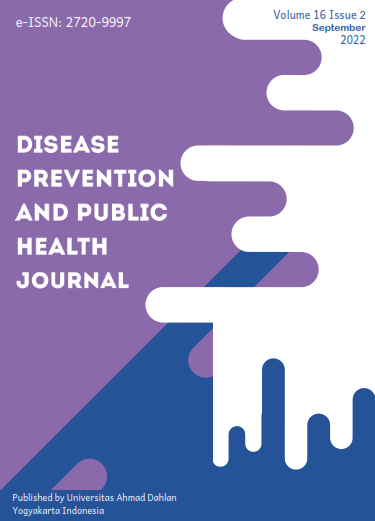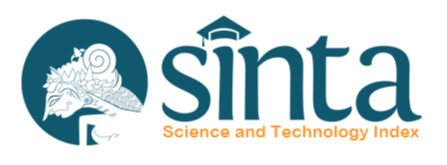Marital Status and Its Effect on Depression in Indonesia: A Case Study of the 2014 Indonesian Family Life Survey
DOI:
https://doi.org/10.12928/dpphj.v16i2.5337Keywords:
Marital Status, Depression, IFLS 5Abstract
Background: Depression is a mental health disorder that makes the sufferer unmotivated and unproductive. This is caused by some factors such as loneliness, perfectionism, and marital status. Riset Kesehatan Dasar (Riskesdas) in 2018 shows that 6.1 percent of the population aged 15 and above in Indonesia experienced depression. Therefore, this study aims to see how marital status affects depression in Indonesia. Method: This study uses logistic regression, marginal effect, and the Rasch model using data from the Indonesian Family Life Surveys (IFLS) in 2014/2015. Result: Analyses showed that married observations have a lower prevalence of depression compared to those who are not married, divorced, or widowed. Conclusion: Therefore, an increase in divorce cases will increase the prevalence of depression in Indonesia. More effort in educating marriage to young couples is needed to reduce the number of divorces in Indonesia.
References
WHO. Depression [Internet]. World Health Organization. 2021 [cited 2021 Jan 21]. Available from: https://www.who.int/news-room/fact-sheets/detail/depression
Arcand M, Juster R-P, Lupien SJ, Marin M-F. Gender Roles in Relation to Symptoms of Anxiety and Depression Among Students and Workers. Anxiety, Stress Coping. 2020;33(6):661–74. doi: https://doi.org/10.1080/10615806.2020.1774560
Kemenkes. Situasi Kesehatan Jiwa di Indonesia [Internet]. Jakarta; 2019. Available from: https://pusdatin.kemkes.go.id/download.php?file=download/pusdatin/infodatin/InfoDatin-Kesehatan-Jiwa.pdf
Domènech-Abella J, Mundó J, Leonardi M, Chatterji S, Tobiasz-Adamczyk B, Koskinen S, et al. The Association Between Socioeconomic Status and Depression Among Older Adults in Finland, Poland and Spain: A Comparative Cross-Sectional Study of Distinct Measures and Pathways. J Affect Disord. 2018;241:311–8. doi: https://doi.org/10.1016/j.jad.2018.08.077
Goldfarb MR, Trudel G. Marital Quality and Depression: A Review. Marriage Fam Rev. 2019;55(8):737–63. doi: https://doi.org/10.1080/01494929.2019.1610136
Ernst M, Kallenbach-Kaminski L, Kaufhold J, Negele A, Bahrke U, Hautzinger M, et al. Suicide Attempts in Chronically Depressed Individuals: What are the Risk Factors? Psychiatry Res. 2020;287:112481. doi: https://doi.org/10.1016/j.psychres.2019.112481
Lawrence EM, Rogers RG, Zajacova A, Wadsworth T. Marital Happiness, Marital Status, Health, and Longevity. J Happiness Stud. 2019;20(5):1539–61. doi: https://doi.org/10.1007/s10902-018-0009-9
Jace CE, Makridis CA. Does Marriage Protect Mental Health? Evidence from the COVID‐19 Pandemic. Soc Sci Q. 2021; doi: https://doi.org/10.1111/ssqu.13063
Nicolini P, Abbate C, Inglese S, Rossi PD, Mari D, Cesari M. Different Dimensions of Social Support Differentially Predict Psychological Well‐Being in Late Life: Opposite Effects of Perceived Emotional Support and Marital Status on Symptoms of Anxiety and of Depression in Older Outpatients in Italy. Psychogeriatrics. 2021;21(1):42–53. doi: https://doi.org/10.1111/psyg.12633
Kojima G, Walters K, Iliffe S, Taniguchi Y, Tamiya N. Marital Status and Risk of Physical Frailty: A Systematic Review and Meta-Analysis. J Am Med Dir Assoc. 2020;21(3):322–30. doi: https://doi.org/10.1016/j.jamda.2019.09.017
BPS. Persentase Penduduk Berumur 10 Tahun ke Atas menurut Provinsi, Jenis Kelamin, dan Status Perkawinan, 2009-2018 [Internet]. Badan Pusat Statistik. 2019 [cited 2022 Jan 22]. Available from: https://www.bps.go.id/statictable/2012/04/19/1602/persentase-penduduk-berumur-10-tahun-ke-atas-menurut-provinsi-jenis-kelamin-dan-status-perkawinan-2009-2018.html
Niu L. A Review of the Application of Logistic Regression in Educational Research: Common Issues, Implications, and Suggestions. Educ Rev. 2020 Jan;72(1):41–67. doi: https://doi.org/10.1080/00131911.2018.1483892
Jain H, Khunteta A, Srivastava S. Churn Prediction in Telecommunication Using Logistic Regression and Logit Boost. Procedia Comput Sci. 2020;167:101–12. doi: https://doi.org/10.1016/j.procs.2020.03.187
Long JS, Mustillo SA. Using Predictions and Marginal Effects to Compare Groups in Regression Models for Binary Outcomes. Sociol Methods Res. 2021;50(3):1284–320.
Connelly L. Logistic regression. Medsurg Nurs. 2020;29(5):353–4.
Opic S. Specifics of Logit and Probit Regression in Education Sciences--Why Wouldn’t We Use It?. Cypriot J Educ Sci. 2020;15(6):1557–68.
Norton EC, Dowd BE, Maciejewski ML. Marginal Effects—Quantifying the Effect of Changes in Risk Factors in Logistic Regression Models. JAMA. 2019 Apr;321(13):1304–5. doi: https://doi.org/10.1177/0049124118799374
Islam AYMA, Gu X, Crook C, Spector JM. Assessment of ICT in Tertiary Education Applying Structural Equation Modeling and Rasch Model. SAGE Open. 2020;10(4):2158244020975409. doi: https://doi.org/10.1177/2158244020975409
Briggs DC. Interpreting and Visualizing the Unit of Measurement in the Rasch Model. Measurement. 2019;146:961–71. doi: https://doi.org/10.1016/j.measurement.2019.07.035
Padgett RN, Morgan GB. Using the eRm Package for Rasch Modeling. Meas Interdiscip Res Perspect. 2020;18(3):163–76. doi: https://doi.org/10.1080/15366367.2020.1732155
Christensen KS, Oernboel E, Nielsen MG, Bech P. Diagnosing Depression in Primary Care: A Rasch Analysis of the Major Depression Inventory. Scand J Prim Health Care. 2019;37(1):105–12. doi: https://doi.org/10.1080/02813432.2019.1608039
Fahmi M, Panjaitan NA, Habibie I, Siregar AYM, Amarullah G, Rahma, et al. Does Your Neighborhood Protect You From Being Depressed? A Study on Social Trust and Depression in Indonesia. BMC Public Health. 2019;19(1):1–8. doi: https://doi.org/10.1186/s12889-019-7657-5
Vaingankar JA, Abdin E, Chong SA, Shafie S, Sambasivam R, Zhang YJ, et al. The Association of Mental Disorders with Perceived Social Support, and the Role of Marital Status: Results From A National Cross-Sectional Survey. Arch Public Heal. 2020;78(1):1–11. doi: https://doi.org/10.1186/s13690-020-00476-1
Whitley R. Family Ties: Marriage, Divorce, and the Mental Health of Men and Boys. In: Men’s Issues and Men’s Mental Health. Springer; 2021. p. 207–34. doi: https://doi.org/10.1007/978-3-030-86320-3_9
YouGov. A Quarter of Indonesians Have Experienced Suicidal Thoughts. 2019.
Hyde JS, Mezulis AH. Gender Differences in Depression: Biological, Affective, Cognitive, and Sociocultural Factors. Harv Rev Psychiatry. 2020;28(1):4–13. doi: https://doi.org/10.1097/hrp.0000000000000230
Joffe H, de Wit A, Coborn J, Crawford S, Freeman M, Wiley A, et al. Impact of Estradiol Variability and Progesterone on Mood in Perimenopausal Women with Depressive Symptoms. J Clin Endocrinol Metab. 2020;105(3):e642–50. doi: https://doi.org/10.1210/clinem/dgz181
UNFPA. New Survey Shows Violence Against Women Widespread in Indonesia. 2017.
Richardson T, Maguire N. Poverty, Depression and Anxiety: The Role of Debt. Science (80-). 2021;
Patel V, Burns JK, Dhingra M, Tarver L, Kohrt BA, Lund C. Income Inequality and Depression: A Systematic Review and Meta-Analysis of the Association and A Scoping Review of Mechanisms. World Psychiatry. 2018;17(1):76–89. doi: https://doi.org/10.1002/wps.20492
Carstensen LL, DeLiema M. The Positivity Effect: A Negativity Bias in Youth Fades with Age. Curr Opin Behav Sci. 2018;19:7–12. doi: https://doi.org/10.1016/j.cobeha.2017.07.009
Baicker K, Allen HL, Wright BJ, Taubman SL, Finkelstein AN. The Effect of Medicaid on Management of Depression: Evidence From the Oregon Health Insurance Experiment. Milbank Q. 2018;96(1):29–56. doi: https://doi.org/10.1111/1468-0009.12311
Taple BJ, Chapman R, Schalet BD, Brower R, Griffith JW. The Impact of Education on Depression Assessment: Differential Item Functioning Analysis. Assessment. 2020;1073191120971357. doi: https://doi.org/10.1177/1073191120971357
Harithasan D, Mukari SZS, Ishak WS, Shahar S, Yeong WL. The Impact of Sensory Impairment on Cognitive Performance, Quality of Life, Depression, and Loneliness in Older Adults. Int J Geriatr Psychiatry. 2020;35(4):358–64. doi: https://doi.org/10.1002/gps.5237
Amiri S. Unemployment Associated with Major Depression Disorder and Depressive Symptoms: A Systematic Review and Meta-Analysis. Int J Occup Saf Ergon. 2021;1–13. Doi: https://doi.org/10.1080/10803548.2021.1954793
Downloads
Published
Issue
Section
License
Copyright (c) 2022 Universitas Ahmad Dahlan

This work is licensed under a Creative Commons Attribution-ShareAlike 4.0 International License.
Authors transfer the copyright and grant the Disease Prevention and Public Health Journal right of first publication with the work simultaneously licensed under a Creative Commons Attribution License (CC BY-SA 4.0) that allows others to share (copy and redistribute the material in any medium or format) and adapt (remix, transform, and build upon the material) the work for any purpose, even commercially with an acknowledgement of the work's authorship and initial publication in Disease Prevention and Public Health Journal. Authors are able to enter into separate, additional contractual arrangements for the non-exclusive distribution of the journal's published version of the work (e.g., post it to an institutional repository or publish it in a book), with an acknowledgement of its initial publication in Disease Prevention and Public Health Journal. Authors are permitted and encouraged to post their work online (e.g., in institutional repositories or on their website) prior to and during the submission process, as it can lead to productive exchanges, as well as earlier and greater citation of published work (See The Effect of Open Access).

This work is licensed under a Creative Commons Attribution-ShareAlike 4.0 International License.







